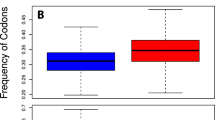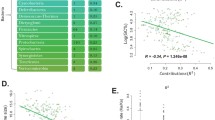Abstract
Codon usage and base composition in sequences from the A + T-rich genome ofRickettsia prowazekii, a member of the alpha Proteobacteria, have been investigated. Synonymous codon usage patterns are roughly similar among genes, even though the data set includes genes expected to be expressed at very different levels, indicating that translational selection has been ineffective in this species. However, multivariate statistical analysis differentiates genes according to their G + C contents at the first two codon positions. To study this variation, we have compared the amino acid composition patterns of 21R. prowazekii proteins with that of a homologous set of proteins fromEscherichia coli. The analysis shows that individual genes have been affected by biased mutation rates to very different extents: genes encoding proteins highly conserved among other species being the least affected. Overall, protein coding and intergenic spacer regions have G + C content values of 32.5% and 21.4%, respectively. Extrapolation from these values suggests thatR. prowazekii has around 800 genes and that 60–70% of the genome may be coding.
Similar content being viewed by others
References
Altschul SF, Gish W, Miller W, Myers EW, Lipman DJ (1990) Basic local alignment search tool. J Mol Biol 215:403–410
Andersson SGE, Kurland CG (1990) Codon preferences in free-living microorganisms. Microbiol Rev 54:198–210
Andersson SGE, Kurland CG (1995) Genomic evolution drives the evolution of the translation system. Biochem Cell Biol 73 (in press)
Andersson SGE, Sharp PM (1996) Codon usage in theMycobacterium tuberculosis complex. Microbiology 142:915–925
Andersson SGE, Zomorodipour A, Winkler HH, Kurland CG (1995) Unusual organization of the rRNA genes inRickettsia prowazekii. J Bacteriol 177:4171–4175
Brown CM, Stockwell PA, Trotman CNA, Tate WA (1990) The signal for the termination of protein synthesis in procaryotes. Nucleic Acids Res 18:2079–2086
Bulmer M (1986) Neighboring base effects on substitution rates in pseudogenes. Mot Biol Evol 3:322–329
Bulmer M (1991) The selection-mutation drift theory of synonymous codon usage. Genetics 129:897–907
Curran JF, Yarns M (1989) Rates of aa-tRNA selection at 29 sense codonsin vivo. J Mol Biol 209:65–77
Dasch GA (1981) Isolation of species-specific protein antigens ofRickettsia typhi andRickettsia prowazekii for immunodiagnosis and immunoprophylaxis. J Clin Microbiol 14:333–341
Dasch GA, Samms JR, Williams JC (1981) Partial purification and characterization of the major species-specific protein antigens ofRickettsia typhi andRickettsia prowazekki identified by rocket immunoelectrophoresis. Infect Immun 31:276–288
Delorme C, Godon JJ, Ehrlich SD, Renault P (1993) Gene inactivation inLactococcus lactis: histidine biosynthesis. J Bacteriol 175:4391–4399
Eremeeva ME, Balayeva NM, Raoult D (1994) Serological response of patients suffering from primary and recrudescent typhus: comparison of complement fixation reaction, weil-felix test, microimmunofluorescence, and immunoblotting. Clin Diag Lab Immun 1:318–324
Eremeeva ME, Roux V, Raoult D (1993) Determination of genome size and restriction pattern polymorphism ofRickettsia prowazekii andRickettsia typhi by pulsed field gel electrophoresis. FEMS Microbiol Lett 112:105–112
Gouy M, Gautier C (1982) Codon usage in bacteria: correlation with gene expressivity. Nucleic Acids Res 10:7055–7074
Gouy M, Gautier C, Attimonelli M, Lanave C, Di Paola G (1985) ACNUC-a portable retrieval system for nucleic acid sequence databases: logical and physical designs and usage. Comput Appl Biosci 1:167–172
Grantham R, Gautier C, Gouy M, Jacobzone M, Mercier R (1981) Codon catalog usage is a genomic strategy modulated for gene expressivity. Nucleic Acids Res 9:r43-r74
Gray MW (1995) Mitochondrial evolution. In: Levings CS III, Vasil IK (eds) Molecular biology of plant mitochondria. Kluwer Academic Publishers BV, Dordrecht, The Netherlands, pp 635–659
Greenacre MJ (1984) Theory and applications of correspondence analysis. Academic Press, London
Gupta RS (1995) Evolution of the chaperonin families (Hsp60, Hsp10 and Tcp-1) of proteins and the origin of the eukaryotic cells. Mol Microbiol 15:1–11
Higgins DG, Bleasby AJ, Fuchs R (1992) CLUSTAL V: improved software for multiple sequence alignment. Comput Appl Biosci 8:189–191
Holm L (1986) Codon usage and gene expression. Nucleic Acids Res 14:3075–3087
Hyde JE, Sims PF (1987) Anomalous dinucleotide frequencies in both coding and non-coding regions from the genome of the human malaria parasitePlasmodium falciparum. Gene 61:177–187
Ikemura T (1981) Correlation between the abundance ofEscherichia coli transfer RNAs and the occurrence of the respective codons in its protein genes: a proposal for a synonymous codon choice that is optimal for theE. coli translational system. J Mol Biol 151:389–409
Jarausch W, Saillard C, Dosba F, Bove JM (1994) Differentiation of mycoplasmalike organisms (MLOs) in European fruit trees by PCR using specific primers derived from the sequence of a chromosomal fragment of the apple proliferation MLO. Appl Environ Microbiol 60:2916–2923
Kimura M (1983) The neutral theory of molecular evolution. Cambridge University Press, Cambridge, UK
Komine Y, Adachi T, Inokuchi H, Ozeki H (1990) Genomic organization and physical mapping of the transfer RNA genes inEscherichia coli K12. J Mol Biol 212:579–598
Kurland CG (1987) Strategies for efficiency and accuracy in gene expression. I. The major codon preference: a growth optimization strategy. Trends Biochem Sci 12:126–128
Labuda D, Grosjean H, Striker G, Porschke D (1982) Codon-anticodon interaction and anticodon-anticodon interaction-evaluation of equilibrium and kinetic parameters of complexes involving a G-U wobble. Biochim Biophys Acta 698:230–236
Lloyd AT, Sharp PM (1992) CODONS: a microcomputer program for codon usage analysis. J Hered 83:239–240
Lloyd AT, Sharp PM (1993) Evolution of therecA gene and the molecular phylogeny of bacteria. J Mol Evol 37:399–407
Lobry JR, Gautier C (1994) Hydrophobicity, expressivity and aromaticity are the major trends of amino-acid usage in 999Escherichia coli chromosome-encoded genes. Nucleic Acids Res 22:3174–3180
Maniloff J (1983) Evolution of wall-less prokaryotes. Annu Rev Microbiol 37:477–500
Medigue C, Rouxel T, Vigier P, Henaut A, Danchin A (1991) Evidence for horizontal gene transfer inEscherichia coli speciation. J Mol Biol 222:851–856
Moulder JW (1985) Comparative biology of intracellular parasitism. Microbiol Rev 49:298–337
Muto A, Osawa S (1987) The guanine and cytosine content of genomic DNA and bacterial evolution. Proc Natl Acad Sci USA 84:166–169
Muto A, Andachi Y, Yuzawa H, Yamao F, Osawa S (1990) The organization and evolution of transfer RNA genes inMycoplasma capricolum. Nucleic Acids Res 18:5037–5043
Ohama T, Muto A, Osawa S (1990) Role of GC-biased mutation pressure on synonymous codon choice in Micrococcus luteus, a bacterium with a high genomic GC-content. Nucleic Acids Res 18:1565–1569
Ohkubo S, Muto A, Kawauchi Y, Yamao F, Osawa S (1987) The ribosomal protein gene cluster ofMycoplasma capricolum. Mol Gen Genet 210:314–322
Olsen GJ, Woese CR, Overbeek R (1994) The winds of (evolutionary) change: breathing new life into microbiology. J Bacteriol 176:1–6
Pang H, Winkler HH (1993) Copy number of the 16S rRNA gene inRickettsia prowazekii. J Bacteriol 175:3893–3896
Pang H, Winkler HH (1994) The concentrations of stable RNA and ribosomes inRickettsia prowazekii. Mot Microbiol 12:115–120
Pedersen S, Bloch PL, Reeh S, Neidhart FC (1978) Patterns of protein synthesis inE. coli: a catalog of the amount of 140 individual proteins at different growth rates. Cell 14:179–190
Rogers MJ, Simmons J, Walker RT, Weisburg WG, Woese CR, Tanner RS, Robinson IM, Stahl DA, Olsen G, Leach RH, Maniloff J (1985) Construction of the mycoplasma evolutionary tree from 5S rRNA sequence data. Proc Natl Acad Sci USA 82:1160–1164
Schmidt J, Bubunenko M, Subramanian AR (1993) A novel operon organization involving the genes for chorismate synthase (aromatic biosynthesis pathway) and ribosomal GTPase center proteins (L11, L1, L10, L12:rpIKAJL) in CyanobacteriumSynechosystis PCC 6803. J Biol Chem 268:27447–27457
Schramek S (1972) Deoxyribonucleic acid base composition of members of the typhus group of rickettsiae. Acta Virol 16:447
Sharp PM, Bulmer M (1988) Selective differences among translation termination codons. Gene 63:141–145
Sharp PM, Devine KM (1989) Codon usage and gene expression level inDictyostelium discoideum: highly expressed geens do “prefer” optimal codons. Nucleic Acids Res 17:5029–5039
Sharp PM, Li W-H (1986) An evolutionary perspective on codon usage in unicellular organisms. J Mol Evol 24:28–38
Sharp PM, Li W-H (1987) The Codon Adaptation Index—a measure of directional synonymous codon usage bias, and its potential applications. Nucleic Acids Res 15:1281–1295
Sharp PM, Stenico M, Peden JF, Lloyd AT (1993) Codon usage: mutational bias, translational selection, or both? Biochem Soc Trans 21:835–841
Shields DC (1990) Switches in species-specific codon preferences: the influence of mutation biases. J Mol Evol 31:71–80
Shields DC, Higgins DG, Sharp PM (1992) GCWIND: a microcomputer program for identifying open reading frames according to codon positional G + C content. Comput Appl Biosci 8:521–523
Shields DC, Sharp PM (1987) Synonymous codon usage inBacillus subtilis reflects both translational selection and mutational biases. Nucleic Acids Res 15:8023–8040
Syvänen A-C, Amiri H, Jamal A, Andersson SGE, Kurland CG (1995) Genomic disposition of elongation factor genes reflects the evolution ofRickettsia prowazekii. (MS submitted)
Thomas LK, Dix DB, Thompson RC (1988) Codon choice and gene expression: synonymous codons differ in their ability to direct aminoacylated-transfer RNA binding to ribosomesin vitro. Proc Natl Acad Sci USA 85:4242–14246
Tubulekas I, Hughes D (1992) Growth and translation rate are sensitive to the concentration of EF-Tu. J Bacteriol 175:240–250
Turco J, Winkler HH (1989) Isolation ofRickettsia prowazekii with reduced sensitivity to gamma interferon. Infect Immun 57:1765–1772
Tyeryar FJ, Weiss E, Millar DB, Bozeman FM, Ormsbee RA (1973) DNA base composition of rickettsiae. Science 180:415–417
van der Meide PH, Vijgenboom E, Dicke M, Bosch L (1982) Regulation of the expression oftufA andtufB, the two genes coding for the elongation factor EF-Tu inEscherichia coli. FEBS Lett 139:325–330
Viale A, Arakaki AK (1994) The chaperone connection to the origins of the eukaryotic organelles. FEBS Lett 341:146–151
Weisburg WG, Tully JG, Rose DL, Petzel JP, Oyaizu H, Yang D, Mandelco L, Sechrest J, Lawrence TG, Van Etten J, Maniloff J, Woese CR (1989) A phylogenetic analysis of the mycoplasmas: basis for their classification. J Bacteriol 171:6455–6467
Williams R, Cotton NPJ, Thomas CM, Jackson JB (1994) Cloning and sequencing of the genes for the proton-translocating nicotinamide nucleotide transhydrogenase fromRhodospirillum rubrum and the implications for the domain structure of the enzyme. Microbiol 140:1595–1604
Winkler HH (1976) Rickettsial permeability: an ATP/ADP transport system. J Biol Chem 251:389–396
Winkler HH, Wood DO (1988) Codon usage in selected AT-rich bacteria. Biochimie 70:977–986
Wisseman CL Jr, Edlinger EA, Waddell AD, Jones MR (1976) Infection cycle ofRickettsia ricketsii in chicken embryo and L-929 cells in culture. Infect Immun 14:1052–1064
Wright F (1990) The ‘effective number of codons’ used in a gene. Gene 87:23–29
Wright F, Bibb MJ (1992) Codon usage in the G + C-richStreptomyces genome. Gene 113:55–65
Yamaguchi M, Hatefi Y (1993) Energy-transducing nicotinamide nucleotide transhydrogenase. Nucleotide-binding properties of the purified enzyme and proteolytic fragments. J Biol Chem 268: 17871–17877
Author information
Authors and Affiliations
Additional information
Correspondence to: S.G.E. Andersson
Rights and permissions
About this article
Cite this article
Andersson, S.G.E., Sharp, P.M. Codon usage and base composition inRickettsia prowazekii . J Mol Evol 42, 525–536 (1996). https://doi.org/10.1007/BF02352282
Received:
Accepted:
Issue Date:
DOI: https://doi.org/10.1007/BF02352282




